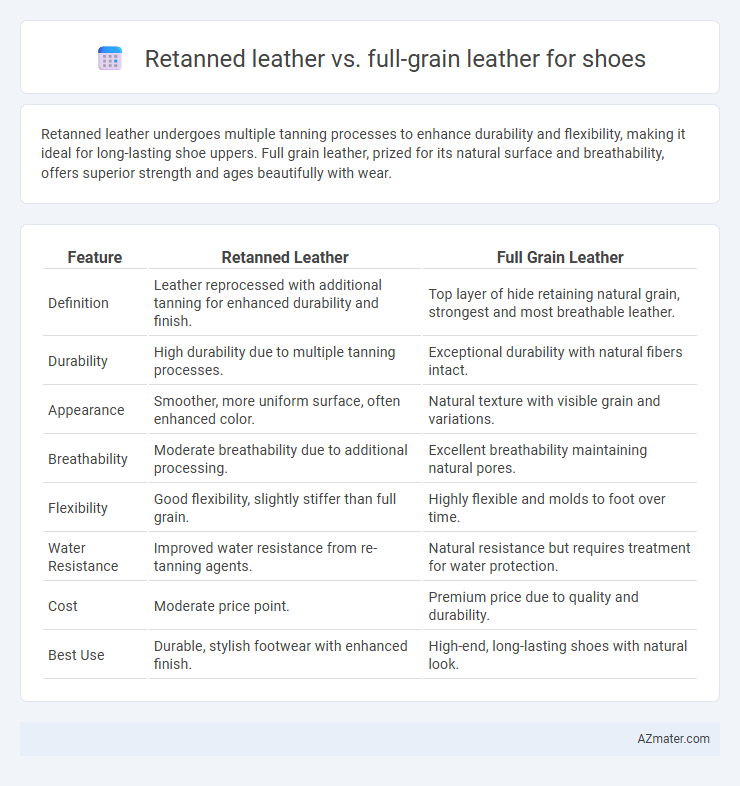Retanned leather undergoes multiple tanning processes to enhance durability and flexibility, making it ideal for long-lasting shoe uppers. Full grain leather, prized for its natural surface and breathability, offers superior strength and ages beautifully with wear.
Table of Comparison
| Feature | Retanned Leather | Full Grain Leather |
|---|---|---|
| Definition | Leather reprocessed with additional tanning for enhanced durability and finish. | Top layer of hide retaining natural grain, strongest and most breathable leather. |
| Durability | High durability due to multiple tanning processes. | Exceptional durability with natural fibers intact. |
| Appearance | Smoother, more uniform surface, often enhanced color. | Natural texture with visible grain and variations. |
| Breathability | Moderate breathability due to additional processing. | Excellent breathability maintaining natural pores. |
| Flexibility | Good flexibility, slightly stiffer than full grain. | Highly flexible and molds to foot over time. |
| Water Resistance | Improved water resistance from re-tanning agents. | Natural resistance but requires treatment for water protection. |
| Cost | Moderate price point. | Premium price due to quality and durability. |
| Best Use | Durable, stylish footwear with enhanced finish. | High-end, long-lasting shoes with natural look. |
Introduction to Retanned Leather and Full Grain Leather
Retanned leather undergoes a secondary tanning process to enhance durability, softness, and water resistance, making it ideal for shoe uppers requiring flexibility and resilience. Full grain leather retains the entire grain layer without sanding, preserving natural markings for superior strength, breathability, and a premium finish in high-quality footwear. Both leathers offer distinct benefits, with retanned leather excelling in treated texture and full grain providing unmatched authenticity and longevity in shoes.
Understanding Retanned Leather: Process and Properties
Retanned leather undergoes an additional tanning process after the initial tanning to enhance its durability, flexibility, and water resistance, making it ideal for shoe uppers that require both strength and comfort. This process typically involves the use of synthetic tanning agents or oils that modify the leather's texture and color, resulting in a more consistent and workable material compared to full grain leather. In contrast, full grain leather retains the natural surface and grain, offering superior breathability and patina development but may require more maintenance and is less uniform in appearance than retanned leather.
What is Full Grain Leather? Characteristics and Benefits
Full grain leather is the highest quality leather, made from the top layer of the hide that includes all grain fibers without sanding or buffing. It boasts superior durability, natural breathability, and develops a rich patina over time, enhancing the shoe's aesthetic appeal. These characteristics make full grain leather ideal for shoes requiring longevity, comfort, and a premium finish.
Durability: Retanned Leather vs Full Grain Leather
Retanned leather undergoes additional tanning processes that enhance water resistance and flexibility but may slightly reduce overall durability compared to full grain leather. Full grain leather retains the natural surface and fiber structure, offering superior strength, breathability, and a longer lifespan for shoes under heavy use. Choosing full grain leather ensures maximum wear resistance and durability, while retanned leather provides a balance of durability with improved softness and moisture control.
Appearance and Texture Comparison
Retanned leather for shoes exhibits a more uniform color and smoother texture due to the additional tanning processes that enhance flexibility and durability. Full grain leather maintains its natural surface, showcasing visible grain patterns and slight imperfections that contribute to a unique, rugged aesthetic. The texture of full grain leather feels firmer and more breathable, while retanned leather offers a softer, more polished finish ideal for formal footwear.
Comfort and Breathability in Shoes
Retanned leather enhances shoe comfort by providing a softer, more flexible texture that reduces break-in time, while full grain leather offers superior breathability due to its natural surface grain, allowing better air circulation and moisture wicking. Shoes crafted from full grain leather typically maintain durability and breathability longer, supporting foot health by preventing excessive sweating and odor buildup. Retanned leather suits those prioritizing immediate comfort and pliability, whereas full grain leather excels in long-term breathability and natural ventilation.
Water Resistance and Maintenance Needs
Retanned leather offers enhanced water resistance due to its additional tanning processes, making it more suitable for shoes exposed to moisture. Full grain leather, known for its natural durability and breathability, requires regular conditioning and waterproofing treatments to maintain water resistance and prevent damage. Both types benefit from proper maintenance, but full grain leather demands more attentive care to preserve its natural texture and longevity.
Cost Differences and Value for Money
Retanned leather typically involves additional processing that can increase production costs, but it often offers enhanced durability and water resistance compared to full grain leather. Full grain leather, prized for its natural texture and breathability, generally commands a higher price due to its premium quality and longevity. Choosing between retanned and full grain leather for shoes depends on balancing upfront cost against long-term value, with full grain leather providing superior investment for durability and aesthetic appeal.
Best Uses: Which Leather for Which Type of Shoe?
Retanned leather offers enhanced durability and water resistance, making it ideal for outdoor and work shoes that require long-lasting protection and rugged performance. Full grain leather, prized for its natural texture and breathability, is best suited for dress shoes and high-end casual footwear where appearance and comfort are paramount. Choosing between retanned and full grain leather depends on the shoe's intended use: retanned leather excels in tough conditions, while full grain leather provides elegance and premium comfort.
Conclusion: Choosing the Right Leather for Your Footwear
Full grain leather retains the natural texture and breathability of the hide, offering durability and a premium look ideal for high-quality shoes. Retanned leather undergoes additional processing to improve softness and flexibility, making it suitable for more comfortable, fashion-forward footwear. Selecting the right leather depends on balancing long-lasting strength with desired comfort and aesthetic preferences in your shoes.

Infographic: Retanned leather vs Full grain leather for Shoe
 azmater.com
azmater.com